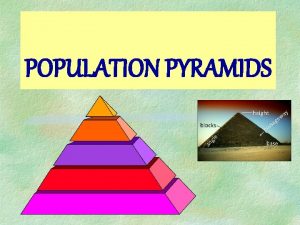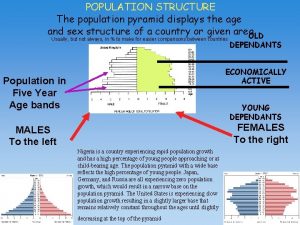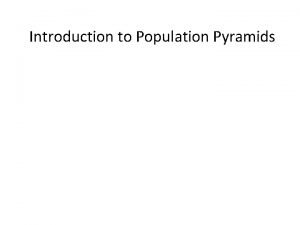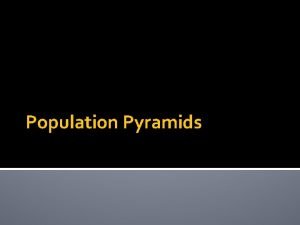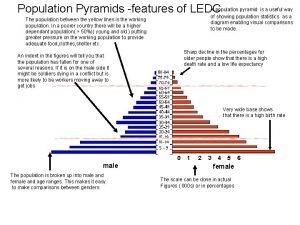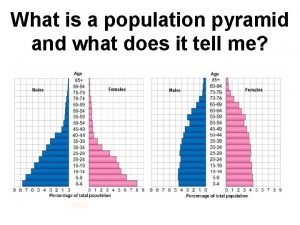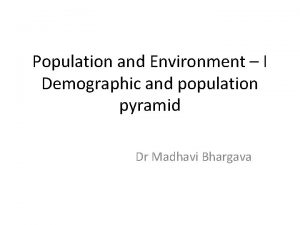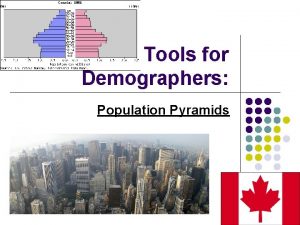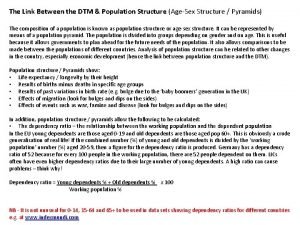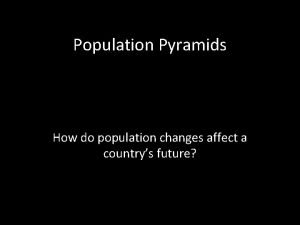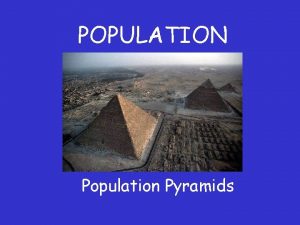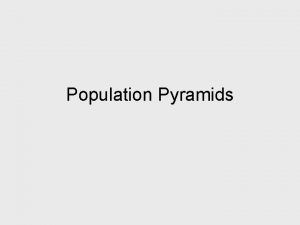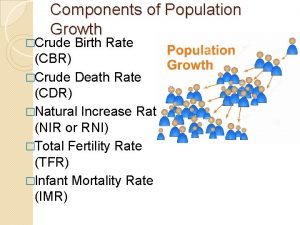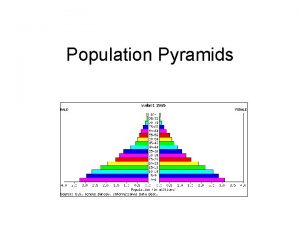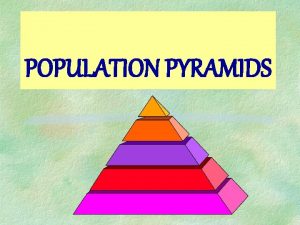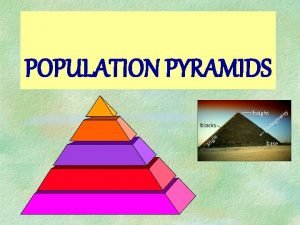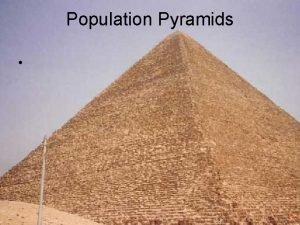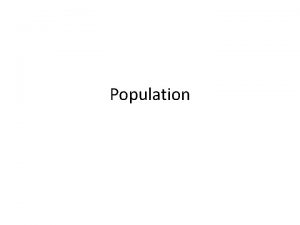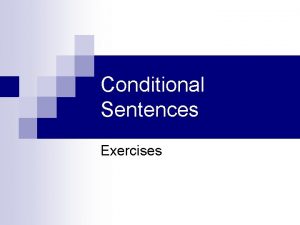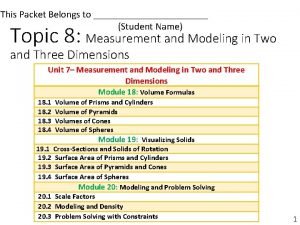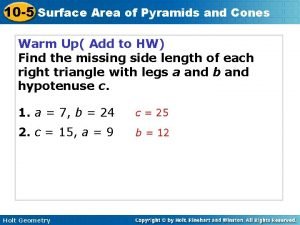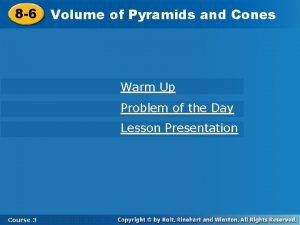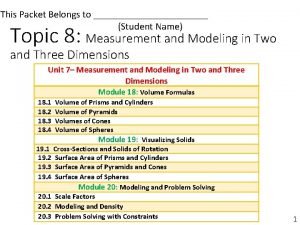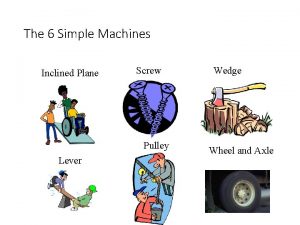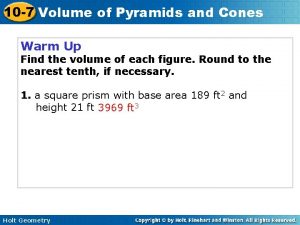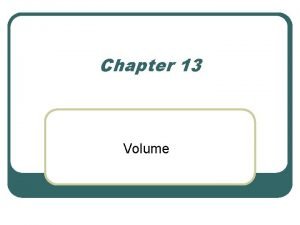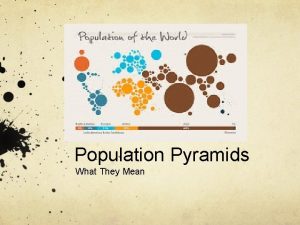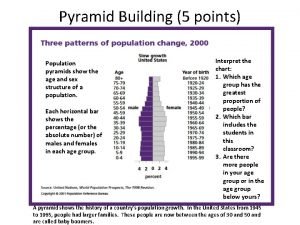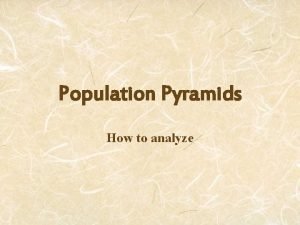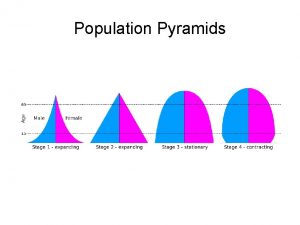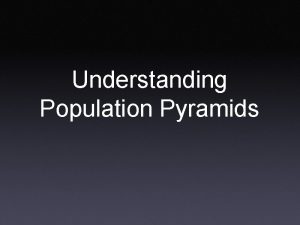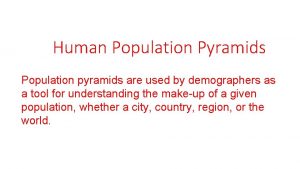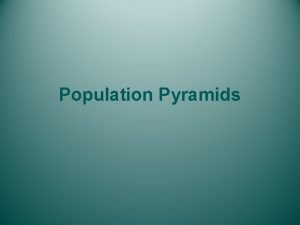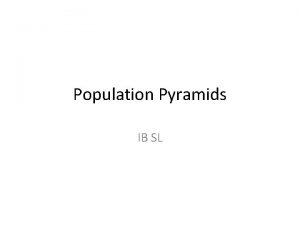Population Pyramids What do they show Population Pyramid




































































- Slides: 68

Population Pyramids What do they show?

Population Pyramid l Shows age structure l Shows sex structure Of a place


What type of growth does this show? Slow b) Rapid c) Moderate d) Shrinking a)

Rapid l Triangular shaped

Rapid l Triangular shaped l Wide base

Rapid l l Triangular shaped Wide base Example: l Laos l Angola l LDCs

Rapid l l Triangular shaped Wide base Example: l Laos l Angola What do these places have in common? l LDC/Developing Nations (3 rd world)

What type of growth does this show? Slow b) Rapid c) Moderate d) Shrinking a)

Moderate l Extended triangle l Base isn’t as wide

Moderate l l Extended triangle Base isn’t as wide Example: l Mexico l Brazil

Moderate Extended triangle l Base isn’t as wide Example: l Mexico l Brazil l Mexico City What do these places have in common l Sao Paulo, Brazil More developed than LDCs, not as developed as others

What type of growth does this show? Slow b) Rapid c) Moderate d) Shrinking a)

Slow l l Column shaped Population is neither increasing or decreasing Example: l United States

Slow Column shaped l Population is neither increasing or decreasing Example: l United States l What is the U. S. considered economically? l MDC

What type of growth does this show? Slow b) Rapid c) Moderate d) Shrinking a)

Shrinking l Top is wider than the base

Shrinking l Top is wider than the base Population is aging l People having less kids l

Shrinking l l l Top is wider than the base Population is aging People having less kids Example: l Italy l Latvia

Shrinking Top is wider than the base l Population is aging l People having less kids Example: l Italy l Latvia l What do these countries have in common? l Europe l MDC

More advanced

What can you tell by this place based on the population pyramid? a) b) c) d) e) College town External War Internal War, famine, epidemic Retirement community Immigrant workers

College town • • What populations are highest? Because college students are usually between the ages of 17 -23

What can you tell by this place based on the population pyramid? a) b) c) d) Soviet Union, 1989 e) College town External War Internal War, famine, epidemic Retirement community Immigrant workers

Internal War, famine, epidemic a) Soviet Union, 1989 Affects both men and women

What can you tell by this place based on the population pyramid? a) b) c) d) e) College town External War Internal War, famine, epidemic Retirement community Immigrant workers

Retirement community • • Lots of old people Very few young people

What can you tell by this place based on the population pyramid? a) b) c) d) e) College town External War Internal War, famine, epidemic Retirement community Immigrant workers

Immigrant workers • • • Most immigrant workers are men What type of work? Construction What type of immigrant work do females do? House work

What can you tell by this place based on the population pyramid? a) b) c) d) e) College town External War Internal War, famine, epidemic Retirement community Immigrant workers

External War • • Less men than women Men usually fight in wars

Age-Dependency Ratio

Age-Dependency Ratio l Working population must support the non -working population. l What ages are considered non-working? l 0 -14, 65 & up

Age-Dependency Ratio Formula (% pop. 0 -14) + (% pop. 65 & up) % pop between 15 -64 X 100

Age-Dependency Ratio Formula l The answer tells us how many dependents there are per 100 people working l For example:

Age-Dependency Ratio Formula Example: Mali - Africa l l l l Population <15: 48 Population 65+: 3 Population 15 -64: 49 48 + 3 = 51 51/49 = 1. 04 x 100 = 104 This means that for every 100 people that work, they have to support 104 people. That’s bad!!!

Disadvantages l Wide base means there a lot of kids l l Young kids can’t support themselves Large burden on society, especially their mothers l l Have to support large families rather than working LDC

Age-Dependency Ratio Formula Example: Germany - Europe l l l l Population <15: 14 Population 65+: 20 Population 15 -64: 66 14 + 20 = 34 34/66 = 5. 15 x 100 = 51. 5 This means that for every 100 people that work, they have to support 52 people. l That’s better, but look how many older people there are than younger people.

Disadvantages What are the two largest percentages of age ranges? l What problem do you think Germany will have in 15 -20 years? l People will start to retire, working population will have a hard time supporting them. l

Disadvantages How can Germany support these people even though they aren’t having many children? l Immigration! l

The Demographic Transition Model

The Demographic Transition Model

The Demographic Transition Model

Stage 1 – Low Growth l CBR and CDR are high l What does this mean for population growth? l Low

Stage 1 - Low Growth l Why are the birth rates and death rates so high?

Sweden’s DTM

CDR - Poor Medicine/Doctors Before modern medicine l Did not sanitize l l l Dr. Nick Did not know about germs No antibiotics

CDR - Infant Mortality Poor medicine/doctors l People had to have more kids because chances were that at least ½ would die l

CBR - Infant Mortality l Most people lived on farms l l Needed kids to work on the farm People had to have more kids because chances were that at least ½ would die

Stage 2 – High Growth Birth Rate still high l Death rate falling l l What dos this mean for population growth? l Rising

Stage 2 – High Growth l Why is the birth rate still high but the death rate declining?

High CBR – Farms and rural areas l Needed free help to work on the farm

High CBR – Little or No Birth Control

Low CDR - Better Medicine/Doctors More sanitary medical facilities l Better trained doctors l Antibiotics l

Population Pyramid for Stage 2 Pyramids for stage two look like triangles l High birth rates l Third World Countries (LDCs) l

Stage 3 – Moderate Growth Birth Rate falling l Death rate falling l l What dos this mean for population growth? l Still rising

Declining CBR - Industrialization l l l Industrialization of economy Less farmers People moving to the city for jobs Less room Smaller families

Declining CBR - Industrialization People moving to the city for jobs l Less room l Smaller families l

Declining CBR – Women’s Place in Society Women have more rights l Better education l Stay in school longer l Have careers l

Population Pyramid for Stage 3 Pyramids for stage three aren’t as wide at the bottom l People living longer l Developing Countries l

Stage 4 – Low Growth Birth Rate steadying l Death rate steadying l l What dos this mean for population growth? l Steadying

Low, Steady CBR – Developed Countries are developed. l People have less kids: l l Women’s rights l l See stage three Kids are expensive

Population Pyramid for Stage 4 Pyramids for stage four are bell shaped l People living longer l Developed Countries l

A th 5 Stage? Most DTMs you will see only have 4 stages. Some demographers believe there is or will be a 5 th.

Stage 5 – Negative Growth Birth Rate declining l Death rate steady l l What dos this mean for population growth? l Declining

Steady CDR l Medicine hasn’t advanced enough since stage 4 to make a difference

Declining CBR l Aging population l People having even less children l European countries rewarding people for having babies.

Population Pyramid for Stage 5 Pyramids for stage five are diamond or upside-down triangular shaped l People having less children l Death rate higher than birth rate l Mostly European Countries l
 Rectangular population pyramid
Rectangular population pyramid Demographic transition model population pyramids
Demographic transition model population pyramids Population structure
Population structure How to read population pyramids
How to read population pyramids Analyzing population pyramids
Analyzing population pyramids Population pyramids
Population pyramids Why do geographers use population pyramids
Why do geographers use population pyramids Population pyramids
Population pyramids Different types of population pyramids
Different types of population pyramids Idb population pyramids
Idb population pyramids Ledc population pyramid
Ledc population pyramid Italy population 1939
Italy population 1939 Constrictive population pyramid
Constrictive population pyramid Beehive shaped pyramid
Beehive shaped pyramid Population pyramids definition
Population pyramids definition Dtm population pyramids
Dtm population pyramids Population pyramids
Population pyramids Which of these pictures
Which of these pictures Convex population pyramid
Convex population pyramid Rectangle population pyramid
Rectangle population pyramid Italy population pyramid
Italy population pyramid Crude birth rate calculator
Crude birth rate calculator Russia depopulation
Russia depopulation Rectangular population pyramid
Rectangular population pyramid Expansive population pyramid
Expansive population pyramid Broad based pyramid
Broad based pyramid Beehive shaped pyramid
Beehive shaped pyramid Stage 1 population pyramid
Stage 1 population pyramid Population of western europe
Population of western europe Newly industrialized country population pyramid
Newly industrialized country population pyramid Newly industrialized population pyramid
Newly industrialized population pyramid Unalaska ak population pyramid
Unalaska ak population pyramid Chapter 4 section 1 population dynamics answer key
Chapter 4 section 1 population dynamics answer key Population ecology section 1 population dynamics
Population ecology section 1 population dynamics Population ecology section 1 population dynamics
Population ecology section 1 population dynamics Chapter 4 section 1 population dynamics
Chapter 4 section 1 population dynamics Because you have rejected me i have rejected you
Because you have rejected me i have rejected you Although they knew god they did not glorify him
Although they knew god they did not glorify him Rankings: what are they and do they matter?
Rankings: what are they and do they matter? They are they which testify of me
They are they which testify of me If we meet him tomorrow we will say hello
If we meet him tomorrow we will say hello Grammar rules frustrate me they're not logical they are so
Grammar rules frustrate me they're not logical they are so They seek him here they seek him there
They seek him here they seek him there For they not know what they do
For they not know what they do In the shadow of pyramids achieve 3000
In the shadow of pyramids achieve 3000 Spine
Spine How to find volume of a triangular prism
How to find volume of a triangular prism Lesson 19-3 surface area of pyramids and cones
Lesson 19-3 surface area of pyramids and cones Ancient egypt pyramid of power
Ancient egypt pyramid of power 6 simple machines
6 simple machines 11-3 volume of pyramids and cones
11-3 volume of pyramids and cones Motor decussation
Motor decussation Cone flat surface
Cone flat surface Pyramids of biomass
Pyramids of biomass Cone formula
Cone formula Is cone a polyhedron
Is cone a polyhedron Amazon rainforest food chain
Amazon rainforest food chain 10-5 surface area of pyramids and cones
10-5 surface area of pyramids and cones Volume pyramids and cones worksheet
Volume pyramids and cones worksheet Lesson 3: surface areas of pyramids and cones
Lesson 3: surface areas of pyramids and cones Tropical rainforest energy pyramid
Tropical rainforest energy pyramid Ecological pyramids worksheet answers biozone
Ecological pyramids worksheet answers biozone Pyramid volume
Pyramid volume Food guide pyramid 1992
Food guide pyramid 1992 Inclined plane pyramids
Inclined plane pyramids 10-7 volume of pyramids and cones
10-7 volume of pyramids and cones How do you find the volume of an oblique cylinder
How do you find the volume of an oblique cylinder Surface area and volume of pyramids worksheet
Surface area and volume of pyramids worksheet Finding the volume of cylinders pyramids cones and spheres
Finding the volume of cylinders pyramids cones and spheres
